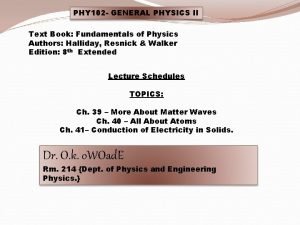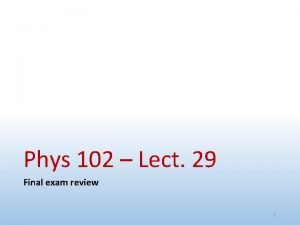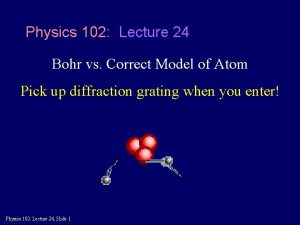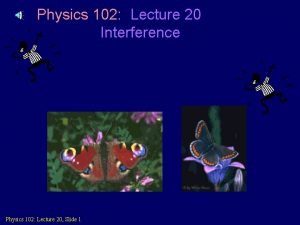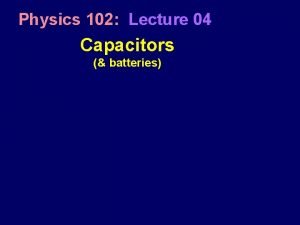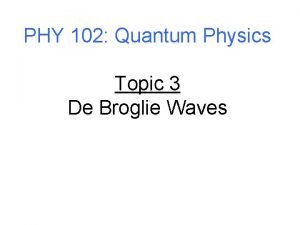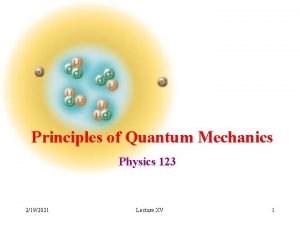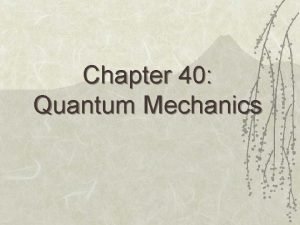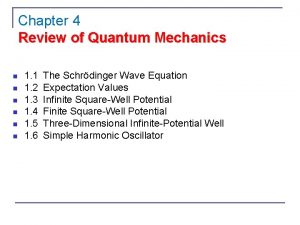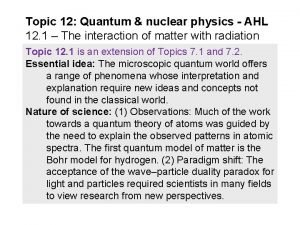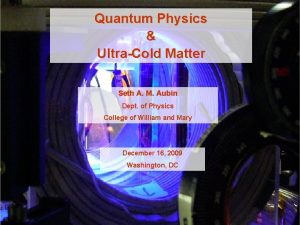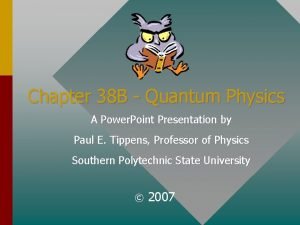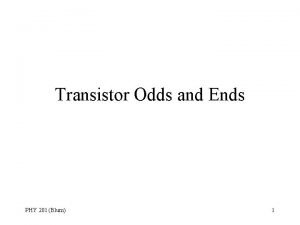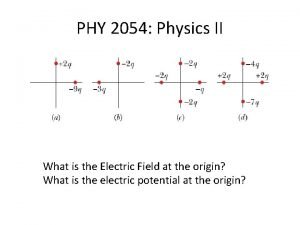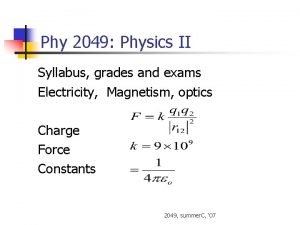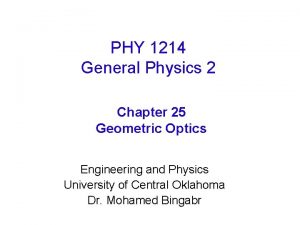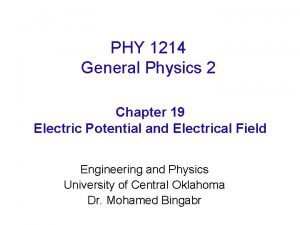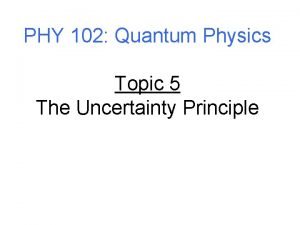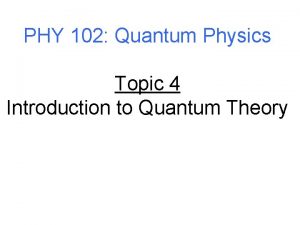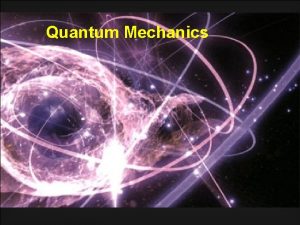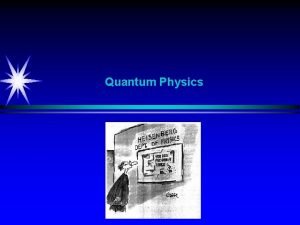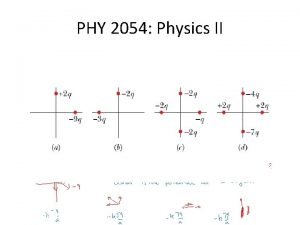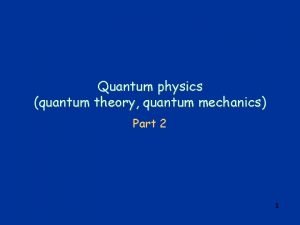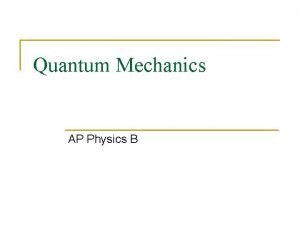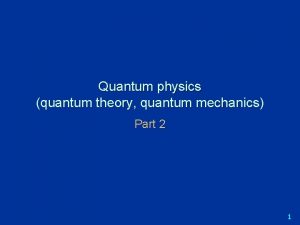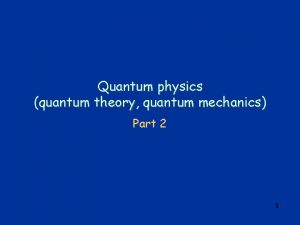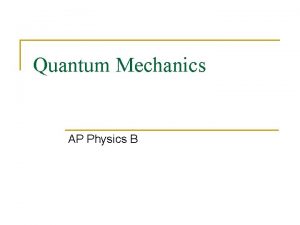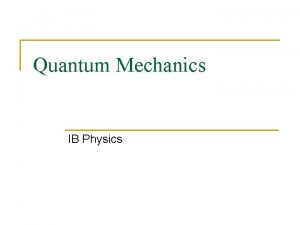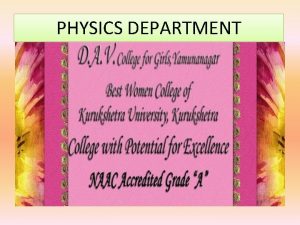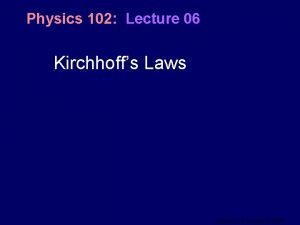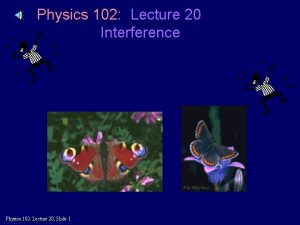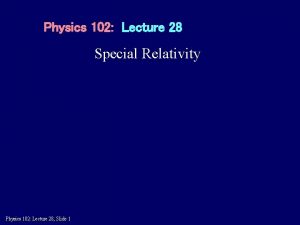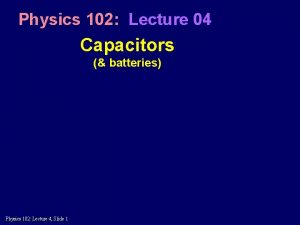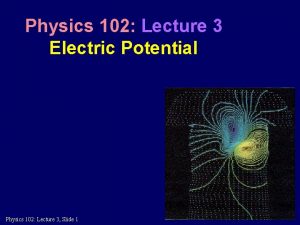PHY 102 Quantum Physics Topic 1 The nature










































- Slides: 42

PHY 102: Quantum Physics Topic 1 The nature of light

Young’s Double Slit Experiment • Demonstrates wave nature of light • Each slit S 1 and S 2 acts as a separate source of coherent light (like the loudspeakers for sound waves)

“real” intensity distribution for double slits…. . light behaving exactly like a wave………. . “ideal” pattern Single slit pattern “real” pattern

What kind of wave (what’s waving? ) • Key point: propagation of a light wave does NOT require a medium • Light can propagate through empty space (vacuum) Consider two of MAXWELL’S EQUATIONS OF ELECTROMAGNETISM: (essentially Faraday’s law and Ampere’s law, respectively)

Electromagnetic Waves • After some mathematical manipulation (see Y 2 electromagnetism) we find that the electric and magnetic fields obey the WAVE EQUATIONS: “standard” linear wave equation

Electromagnetic Waves

Energy in Electromagnetic Waves • For a wave, intensity = energy flow through unit area per unit time = P/A • In the case of an EM wave, intensity corresponds to the “brightness” of the radiation • Studies of the PHOTOELECTRIC EFFECT by Lennard (~1900) gave results that could not be explained by the classical wave picture of light………

The photoelectric effect • In a metal, the flow of electric current is due to the flow of charged particles called electrons • The electrons are relatively free to move throughout the metal (electron “gas” or “sea”), so most metals are good conductors of electricity. • By shining light on a metal, some of these electrons can be “knocked out” of the metal to generate an electric current outside of the metal • Although basic photoelectric effect can be explained with classical wave model of light, the detailed results of such an experiment CAN NOT!. . .

Electrons in metals • Electrical current arises from the flow of charged particles, usually electrons. • In the “Drude model” of a metal, there are many free electrons, which behave like an ideal gas of charged particles. • Because of this large number of free, charged particles, metals are usually very good electrical conductors. • If electrons in a metal behave as an ideal gas, we expect them to have a spread of kinetic energies………………….

Maxwell-Boltzmann velocity distribution • The probability that a molecule has a speed between v and v + dv is f(v) dv where:

Electrons in metals • Electrons don’t normally spontaneously leak out of the metal – there must be something that keeps them in place Swimming pool analogy WALL WATER Water is confined by a region of increased gravitational potential energy (ie the wall!)

Electrons in metals METAL SURFACE E=Emax ELECTRON GAS E=0 Electrons are confined by a region of increased electrostatic potential energy (ie the metal surface) The extra energy required to remove the most energetic electrons from the metal is called the WORK FUNCTION, , of the metal

Detection of emitted electrons Vacuum A

Detection of emitted electrons Vacuum electrons CURRENT FLOW A ENERGY IN

Photoelectric Effect Vacuum electrons CURRENT FLOW A MONOCHROMATIC LIGHT IN VARIABLE VOLTAGE

The photoelectric effect • Metallic anode and cathode enclosed in evacuated glass tube (like old-fashioned electronic “valve”) • Vacuum required so that electrons can flow from cathode to anode without scattering from gas molecules. Potential divider to vary anode-cathode voltage Vac • Monochromatic light is shone on the cathode, electrons flow from cathode to anode, current detected by galvanometer.

The photoelectric effect • Pink lines: electric field lines • because electrons are negatively charged, they move in the opposite direction to the field lines. • When the cathode is illuminated with light of frequency above a certain “threshold frequency” a current is detected, ie photoelectrons must be ejected from the metal….

The photoelectric effect • When the cathode is illuminated with light of frequency above a certain “threshold frequency” a current is detected, ie photoelectrons must be ejected from the metal…. Electrons emitted INSTANTANEOUSLY even for the lowest intensity of light • If the frequency of the incident light is below the threshold frequency, no electrons emitted, no matter how intense the light is. • If light were behaving entirely like a classical EM wave, its power would be proportional to intensity, but independent of frequency (mechanical wave energy proportional to amplitude and frequency, EM wave energy proportional to amplitude (intensity) only) • Would expect intense light of any frequency to generate photoelectrons, and also “time delay” for photoemission due to light of low intensity…………. .

The photoelectric effect: detailed results battery polarity reversed to impede flow of photoelectrons from cathode to anode current proportional to light intensity

The photoelectric effect: detailed results battery polarity reversed to impede flow of photoelectrons from cathode to anode Stopping potential proportional to light frequency

Significance of the stopping potential • If we assume the electrons in the metal behave like a classical ideal gas (? ), then they won’t all have the same velocity (Maxwell velocity distribution) • In other words, they won’t all have the same kinetic energy • The stopping potential is the voltage required to stop the MOST ENERGETIC electrons from leaving the metal

Einstein’s postulate A beam of light can be treated as a stream of particles (PHOTONS) with zero rest mass Each photon has energy: where h is a constant (Planck’s constant, h ≈ 6. 63 x 10 -34 Js) f, λ, c, are frequency, wavelength and velocity of light (in vacuum) respectively. Light intensity is proportional to PHOTON FLUX (no of photons passing through unit area per second)

Results of photoelectric effect: the photon model • When the cathode is illuminated with light of frequency above a certain “threshold frequency” a current is detected, ie photoelectrons must be ejected from the metal…. Electrons emitted INSTANTANEOUSLY even for the lowest intensity of light • Photons behave like “bullets” with energy hf, which can “hit” the electrons. If f is high enough, a single photon can instantaneously remove an electron from the metal • Photo current is proportional to light intensity (if f is above threshold frequency). • Light intensity = number of photons hitting surface per second • Current = number of electrons emitted from surface per second.

Results of photoelectric effect: the photon model • So, in terms of the photon model, the stopping potential is related to the photon frequency, Planck’s constant, and the work function of the metal: By measuring V 0 as a function of f, we can measure Planck’s constant and the work function of the metal……………….

Example Calculation 1 • In a photoelectric experiment a reverse potential of 2 V is required to stop the flow of current for light of a certain frequency. Calculate a) the maximum kinetic energy and b) the maximum velocity of the emitted photoelectrons……. .

The Compton Effect

Photons: summary so far • Einstein postulated the existence of a particle called a photon, to explain detailed results of photoelectric experiment. • Photon has zero rest mass, travels at speed of light • Explains “instantaneous” emission of electrons in photoelectric effect, frequency dependence. • Further confirmation of the photon picture provided by the COMPTON EFFECT (1922 -23)…………………

A reminder about relativity…… • Einstein’s Special Theory of Relativity, 1905: • The laws of physics are the same in every inertial frame of reference (in which Newton’s first law is valid) • The speed of light in a vacuum is the same in all inertial frames of reference, and is independent of the motion of the source. (corollary: the velocity of light can’t be exceeded) Many important consequences: length contraction, time dilation effects at high speeds, mass/energy equivalence……

A little bit about relativity…… Momentum and kinetic energy at high speeds…………….

Relativistic expressions for energy and momentum (energy of stationary particle = mc 2)

Relativistic expressions for energy and momentum

consequently, particle with zero rest mass (eg photon) has momentum p given by:

The Compton Effect • x-rays scattered from target containing very loosely bound electrons • Wavelength of scattered x-rays found to be different from that of incident X-rays AND to depend on detection angle :

The Compton Effect

Compton Effect explained by photon model: Treat Compton scattering as a 2 -particle collision between photon and initially stationary electron, obeying conservation laws for energy and momentum: Before photon electron pi photon After pe pf

Compton Scattering: Conservation of momentum Vector triangle: pf pe pi Consider magnitudes of vectors pi, pf and pe:

Compton Scattering: Conservation of energy We are dealing with velocities at, or close to, speed of light so need to use relativistic expressions: Initial energy: Final energy general expression

Compton Scattering: Conservation of energy Divide both sides by c 2 (be careful!………)

Compton Scattering: Conservation of energy & momentum Energy momentum

Compton Scattering: Conservation of energy & momentum =

Compton Scattering: Conservation of energy & momentum

Compton Scattering: Summary The observed experimental result: Is entirely explained by the photon-electron scattering model. Further proof of the validity of the photon concept. • maximum wavelength shift for = 180°, Δλ=2 h/mc • h/mc is known as the COMPTON WAVELENGTH of the electron.
 Origin of quantum mechanics
Origin of quantum mechanics Quantum physics vs mechanics
Quantum physics vs mechanics Làm thế nào để 102-1=99
Làm thế nào để 102-1=99 Physics 102 electricity and magnetism
Physics 102 electricity and magnetism Uiuc physics 102
Uiuc physics 102 Physics 102
Physics 102 Physics 102 final exam
Physics 102 final exam Electric potential lecture
Electric potential lecture Physics 102
Physics 102 Physics 102
Physics 102 Physics 102
Physics 102 Physics 102
Physics 102 Quantum and nuclear physics
Quantum and nuclear physics Quantum physics wave function
Quantum physics wave function Electromagnetism khan academy
Electromagnetism khan academy Ap quantum physics
Ap quantum physics Quantum physics wave function
Quantum physics wave function Time dependent schrodinger wave equation
Time dependent schrodinger wave equation Quantum nuclear physics
Quantum nuclear physics Seth aubin
Seth aubin Electron volt to volt
Electron volt to volt Quantum physics in hindi
Quantum physics in hindi Concluding sentence
Concluding sentence Topic about internet
Topic about internet Phy 131 past papers
Phy 131 past papers Phy 231 msu
Phy 231 msu Great orthogonality theorem
Great orthogonality theorem Phy 221 msu
Phy 221 msu Phy theorem
Phy theorem Phy113
Phy113 Phy 121 asu
Phy 121 asu Ddr phy architecture
Ddr phy architecture Phy 205
Phy 205 Eye phy
Eye phy Phy 2049
Phy 2049 Phy
Phy Phy
Phy Phy
Phy Atm basics
Atm basics Phy
Phy Phy 2049
Phy 2049 Phy 1214
Phy 1214 Phy 1214
Phy 1214





